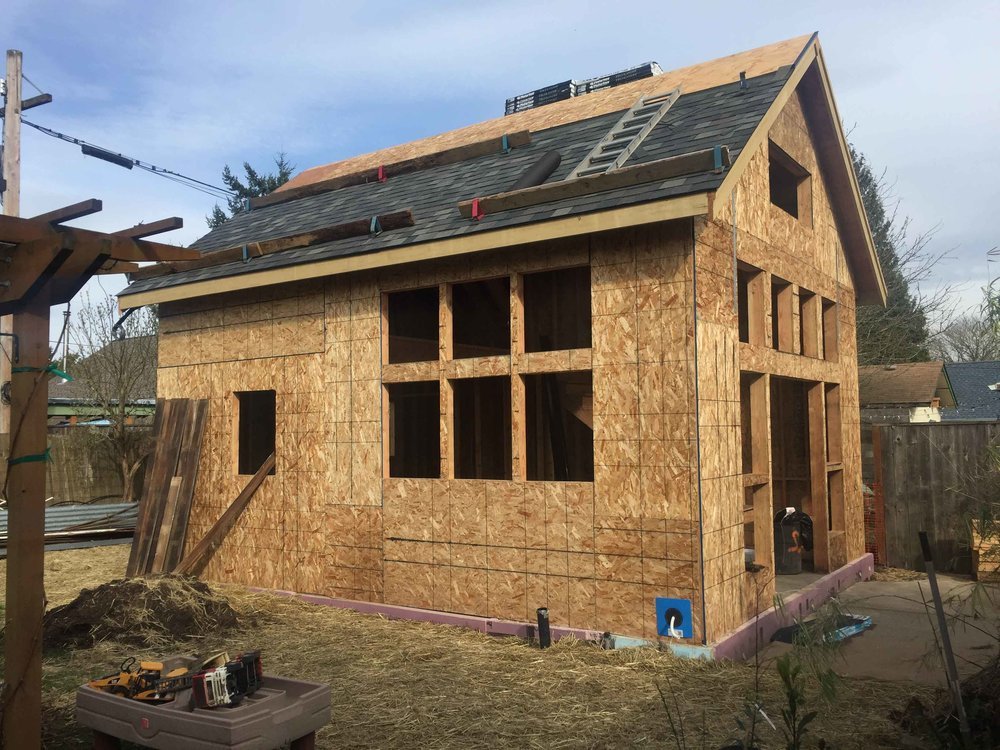Construct
→ Get bids and hire a contractor
→ Understand your role during construction
Project Timeline
The Construction phase typically takes 6-12 months. Most ADU projects take 12-18 months to complete, but some extend to 24 months or more.
Construction FAQs
Here are a few of the most frequently asked questions about ADU construction. See the content below and our ADU Guidebook for more guidance, resources, and tips for all steps of the process.
-
If you are not using a design/build firm, you will need to find a contractor to take over for the construction phase of your ADU.
First, you’ll solicit bids. See our Guidebook for more details on what you want to see in a bid, what other documentation to collect from potential contractors, and what to look for in your bidding candidates. You will want to get at least three bids for comparison.
When you have bids, you can begin selecting your contractor. See our Guidebook for more details on how to compare bids and choose the best option for you.
Before you hire a contractor, make sure to check their license and insurance and when they present you with a contract, review everything carefully. See our Guidebook for more details.
-
Construction costs for your ADU will vary significantly depending on personal preferences, site conditions, location, and many other factors.
Size: Despite what many think, smaller ADUs may cost almost the same as larger ones. Many costs like foundation, kitchen and bathroom work only increase slightly for larger ADUs. Kitchen costs will range from $25,000–$50,000 with each bathroom ranging from $15,000–$25,000.
Type: New construction, both detached and attached, tend to be the most expensive. Garage conversions are not much cheaper than new construction if at all. Conversions of interior space (basement or otherwise) are often the cheapest.
Other factors:
Quality of interior finish work and amenities
Architectural form and details
Extent of utility, structural, mechanical, electrical, and plumbing upgrades required
Required site upgrades (sidewalks, sewer and water)
Whether sprinklers are required
Whether doors and windows meet emergency exit standards
Lot complexity (slope, trees, fault lines, etc.)
-
Traditional construction will take 6-12 months, though this will vary depending on the specifics of the project. Stages of construction include:
Site preparation: 1-2 months
Foundation: 1 month
Walls, roof, doors: 1-2 months
Plumbing & electrical: 1-2 months
Insulation & drywall: ½-1 month
Fixtures & finishes: 1-2 months
Final touches: ½-2 months
-
While your contractor will lead the construction process, you will have the following responsibilities:
Keep in touch with your contractor and set up a schedule for checking in.
Regularly walk through the construction area to monitor the quality of the work and make sure the work is progressing the way you expect.
Be prepared to make decisions about the details—light fixtures, appliances, and other materials—in a timely manner so your contractor can stay on schedule.
Follow the contract you agreed to, including any changes as described specifically in a change order form.
Although your contractor will usually arrange the required inspections, it is your responsibility as the property owner to make sure that the inspections are conducted as required.

Construction Key Resources
These guides and resources are here for you as you get familiar with the process of building your dream ADU.
ADU GUIDEBOOK
A step-by-step guide to building an ADU in Alameda County
ADU CALCULATOR
Estimate ADU costs and potential income
Construction
Permit in hand, you’re ready to break ground and see your project become a reality! From site preparation to passing your final inspection, you’ll stay in touch with your contractor and make final decisions about project details.
Keep in mind …
Often, people who are their own general contractors have a difficult time. Building an ADU is more like building an entire home than a renovation. If you’re working with a design/build team or have hired a general contractor, they’ll manage the project (including contract negotiation, payment schedules, quality checks, and working with planning and building staff and other agencies). While it may cost more up front, you might save a lot of money by reducing delays or change orders, and get your ADU rented sooner too.
Hire your contractor
If you are not using a design/build firm, you will need to hire a contractor for the construction phase of your ADU. Start by asking around your community for recommendations, and use social media like Nextdoor and Instagram to search for local businesses and find examples of their work. You can also ask your architect or design team to recommend a contractor they’ve previously worked with. You will use drawings from your designer to get bids from contractors, and make sure you are specific about what you want each bid to include (license details, insurance information, examples of past work, etc.). Your design team may be able to help you with this.
It’s a good idea to select between at least three bids, and it’s okay to ask contractors clarifying questions about their bid. Your designer may be able to help you compare the bids. It’s a good idea to reach out to references and to consider your personal interactions with the contractor – you’ll want to feel like you work well together and that they understand your goals.
See our Guidebook for many more details on getting bids and hiring a contractor.
Monitor construction
Once you have building permits, the contractor you hire will lead the construction of your ADU. Be sure you have all funding in place before you start construction.
Communicate frequently with your contractor to make decisions about fixtures and finishes as needed and verify progress before making payments. Timelines for construction vary, but 6-12 months is fairly common. See more details about managing construction in our Guidebook.
Get inspections
During construction, your ADU will be inspected multiple times to ensure it is being built according to the permitted plans (typical inspections include foundations/footings, framing, electrical/plumbing, and exterior finishes).
Many locations have online portals or direct phone numbers for scheduling inspections. Generally, it is your and your contractor’s responsibility to schedule all required inspections. For a list of inspections and how to schedule contact your Building Department. After your final inspection is approved some locations will issue a certificate of occupancy. Your ADU is ready for move-in!
Construction Costs
ADU construction costs vary significantly depending on materials, site conditions, location, and other factors.
The cost to build an ADU typically ranges from $30,000 for a simple interior conversion JADU, to $400,000+ for a large detached ADU with high-end finishes on a hillside lot. Cost per square foot is a good way to estimate, though this too can range from $150-500 per square foot depending on the complexity and finishes of your project. A good starting estimate of construction costs is $425 to $500 per square foot for an average project (with $450 to $550 per square foot as a good starting estimate for total costs, including design, permitting and construction).
Despite what many think, smaller ADUs may cost almost the same as larger ones because construction costs are not related to size. Many costs like foundation, kitchen and bathroom work only increase slightly for larger ADUs. Kitchen costs will range from $25,000–$50,000 with each bathroom ranging from $15,000–$25,000.
Visit our Stories to see real-world cost examples for ADUs built in Alameda County.
Learn from others in your community
Shruti, Livermore
We moved to Livermore and started an in-home preschool to spend more time with the family. By chance, a neighbor suggested building an ADU. The ADU ended up giving my family the privacy we needed and more space for our family from overseas.”
Growing my business and creating space for our family in Livermore
Estimate the cost of your ADU project.
Play with size, type of construction, rents, and other variables to see what affects your ADU cost plus possible return on investment (ROI).

Explore the construction process in detail in our ADU Guidebook
Your go-to, in-depth guide to building an ADU in Alameda County, from inspiration to move-in.
← Back
Permit
Next →











